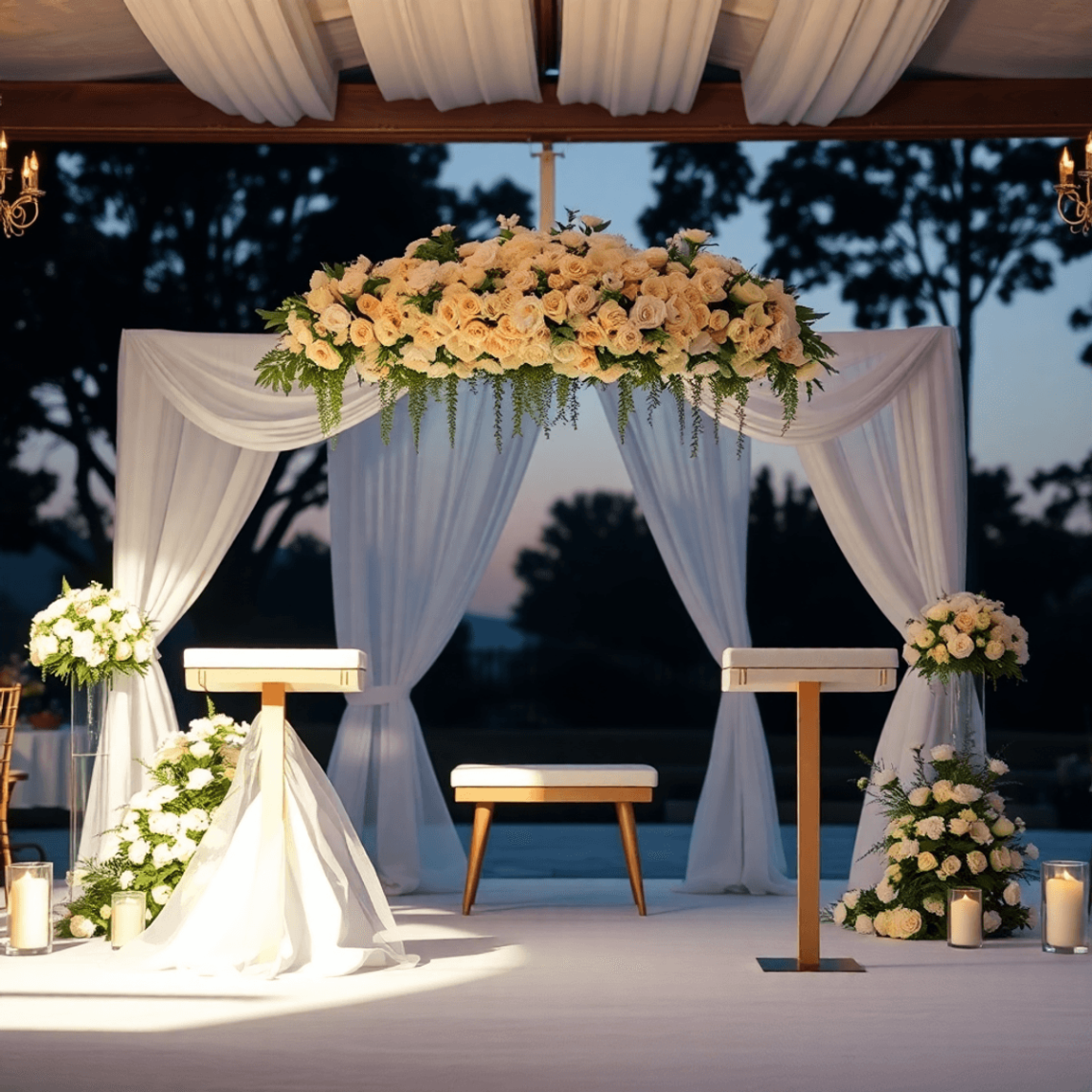Introduction
The age-old question of “What side does the bride stand on?” has intrigued couples planning their weddings for generations. In traditional Western ceremonies, you’ll find the bride positioned on the left side of the altar, with the groom standing proudly on her right. This classic arrangement stems from historical practices and cultural beliefs that have shaped wedding ceremonies across centuries.
Modern couples now face exciting choices when deciding their altar positions. While some embrace time-honored traditions, others opt for personalized arrangements that reflect their unique relationship dynamics and practical considerations. You might choose your standing position based on:
- Personal comfort and preference
- Religious or cultural customs
- Photography and lighting requirements
- Venue layout and guest visibility
This guide explores the rich history behind bride positioning, examines diverse cultural practices, and helps you make an informed decision about your altar placement. Whether you’re planning a traditional ceremony or creating your own contemporary celebration, understanding these customs empowers you to choose an arrangement that feels authentic to your special day.
Historical Context of Bride’s Positioning in Wedding Ceremonies
The practice of positioning the bride on the left side of the groom stems from a rather dark historical tradition known as “marriage by capture.” During medieval times, men would kidnap women from neighboring villages to take as brides. This practice required the groom to hold his bride with his left hand while keeping his right hand free to wield his sword against any attempting rescuers or rival suitors.
This positioning became deeply ingrained in wedding ceremonies, particularly in Western cultures. The groom’s right side – his “sword arm” – needed to remain unencumbered to defend against:
- The bride’s family attempting to reclaim her
- Other suitors who might challenge the union
- Potential attackers or raiders during the ceremony
The concept of chivalry played a significant role in cementing this tradition. Knights were expected to protect their ladies, and the altar positioning reflected this duty. The bride stood on the groom’s left side, closest to his heart, while his right arm remained ready for combat – a symbolic gesture of both love and protection.
These customs influenced many other wedding traditions still practiced today:
- The best man’s original role as the groom’s armed backup
- The bride standing to the left in church ceremonies
- The traditional placement of wedding rings on the left hand
The historical significance of these positions reflects the evolution of marriage from a practice often marked by conflict to one of mutual consent and celebration. This transformation shows how wedding customs adapt while maintaining connections to their historical roots.
Traditional Bride Standings in Different Cultures
Wedding ceremonies around the world have their own special customs and traditions, especially when it comes to how the bride and groom stand during the ceremony. These traditions are a reflection of cultural values and historical significance.
Western Weddings: The Standard Positions Explained
In traditional western weddings, the bride stands on the left side of the altar while the groom takes his position on the right. This arrangement has practical reasons that go back to medieval times:
- Left-Side Positioning: The bride’s position on the left creates a clear path for the groom’s right hand to remain free
- Right-Hand Access: This placement allows the groom to draw his sword if needed, maintaining readiness for potential threats
- Guest Perspective: From the guests’ viewpoint, the bride appears on the right side, creating a balanced visual arrangement
But there’s more to this positioning than just history. It also carries symbolic meaning:
- Protection Symbol: The groom’s placement signifies his role as the bride’s protector
- Heart Alignment: The bride stands to the left, closer to the groom’s heart
- Traditional Procession: This arrangement allows the bride to emerge from the left side of the church, creating a natural flow for the ceremony
Christian wedding ceremonies particularly emphasize this arrangement through specific elements:
- The father walks on the bride’s right side during the processional
- The best man stands to the right of the groom
- The maid of honor positions herself to the left of the bride
These positions create a harmonious ceremony flow while maintaining traditional symbolism. Many modern couples choose to maintain this arrangement out of respect for tradition, even when adapting other aspects of their ceremony to contemporary preferences.
The standard positioning also influences practical aspects of the ceremony:
- Ring Exchange: The arrangement facilitates smooth ring exchanges between the couple
- Ceremonial Flow: The positioning creates natural movement patterns for key moments
- Photography: Traditional angles and shots are optimized for this arrangement
2. Jewish Weddings: Understanding the Bride’s Placement on the Right Side
Jewish wedding ceremonies have a unique way of positioning the bride and groom compared to traditional customs. During the ceremony, the bride stands on the right side, which is different from Western Christian practices. This arrangement is based on sacred Jewish texts and cultural symbolism.
The Significance of the Bride’s Placement
The positioning of the bride and groom draws inspiration from Psalm 45:10, which states “The queen stands at your right hand.” This biblical reference establishes the bride’s place of honor at the right side of her groom during the wedding ceremony.
Symbolic Elements in Jewish Wedding Customs
Jewish wedding customs incorporate several symbolic elements that reinforce this positioning:
- The bride’s placement on the right represents her status as the “crown” of her husband
- This arrangement allows the bride to circle the groom seven times during the ceremony
- The right side symbolizes strength and divine blessing in Jewish tradition
The Chuppah Ceremony and Its Significance
The Chuppah ceremony highlights the significance of this positioning. As the bride stands under the wedding canopy on the right:
- She faces Jerusalem when possible
- The arrangement facilitates the exchange of rings
- It creates an optimal setup for the breaking of the glass
Rabbi-officiated ceremonies maintain strict adherence to these traditional positions. The arrangement carries deep spiritual meaning, reflecting the bride’s elevated status in Jewish marriage customs. This right-side placement creates a sacred space where both partners stand as equals under divine blessing.
Practical Aspects of Jewish Wedding Rituals
The positioning also accommodates practical aspects of Jewish wedding rituals, allowing seamless execution of ceremonial customs while maintaining religious significance. Modern Jewish couples often preserve this traditional arrangement as a connection to their cultural heritage.
3. Hindu Weddings: Embracing Flexibility in Bride’s Positioning Throughout Rituals
Hindu wedding ceremonies showcase a unique approach to the bride’s positioning, characterized by dynamic movement and symbolic changes throughout the rituals. Unlike the fixed positions in Western or Jewish ceremonies, Hindu weddings incorporate multiple ceremonial stages where the bride’s placement holds specific spiritual significance.
Key Ritual Positions
- During Vara Puja: The bride sits on her father’s left side to welcome the groom
- For Kanyadaan: She sits on her father’s right side when being given away
- Throughout Saptapadi: The couple switches sides multiple times while taking their seven sacred steps
- In Mangal Pheras: The bride leads the groom in clockwise circles for three rounds, then follows him for four rounds
The fluid nature of these position changes reflects the Hindu philosophy of balance and harmony between masculine and feminine energies. Each movement serves a specific purpose in the ceremony’s spiritual progression.
This adaptable approach allows for:
- Natural flow between different ritual segments
- Equal representation of both families’ traditions
- Accommodation of regional variations in customs
- Integration of modern interpretations while maintaining sacred elements
The bride’s changing positions symbolize the journey from daughter to wife, with each placement marking significant transitions in her life status. Some ceremonies might include additional regional customs that further influence positioning, such as the Grahshanti ritual where the bride faces east while the groom faces west to honor specific deities.
These varying positions create opportunities for photographers to capture diverse angles and meaningful moments throughout the ceremony, adding depth to the visual documentation of these sacred traditions.
Modern Interpretations and Personalization in Wedding Customs
Contemporary weddings have evolved beyond rigid traditions, embracing personalization as a core element of ceremony planning. The question “What side does the bride stand on?” now reflects a broader shift towards customization in wedding practices.
Modern couples are rewriting traditional rules by:
- Creating symmetrical altar arrangements where both partners stand at equal distances
- Switching sides based on personal preference or meaningful symbolism
- Incorporating same-sex wedding adaptations that challenge conventional positioning
- Designing ceremony spaces that allow for circular or non-traditional layouts
Your wedding positioning can reflect personal significance through:
- Family Traditions – Honoring specific cultural elements while adapting others
- Venue Layout – Working with unique architectural features or outdoor settings
- Personal Comfort – Choosing sides based on individual preferences or physical needs
- Symbolic Meaning – Creating new traditions that represent your relationship
This shift towards personalization has transformed wedding ceremonies into unique expressions of couple identity. Wedding planners and officiants now encourage couples to view traditional positioning as a starting point rather than a strict requirement.
The freedom to choose positioning allows couples to design ceremonies that feel authentic and meaningful. Many couples mix elements from different cultural traditions or create entirely new arrangements that better represent their relationship dynamics.
Considering Aesthetic Factors and Personal Comfort When Choosing a Side at The Altar
The visual impact of your wedding ceremony deserves careful consideration when deciding which side to stand on. Professional wedding photographers understand that lighting plays a crucial role in capturing those perfect moments.
Key Photography Considerations:
- Natural light from windows or outdoor settings can create dramatic shadows or unwanted glare
- The position of artificial lighting in indoor venues affects the quality of photos
- Your “good side” might influence your preferred placement at the altar
- The angle of decorative elements and floral arrangements can frame photos differently
Your personal comfort at the altar shapes your entire ceremony experience. Some brides prefer standing on a specific side based on physical factors:
- Left-handed vs. right-handed preferences for holding the bouquet
- The style and design of your wedding dress
- Placement of dress details you want to highlight
- Your hairstyle and how it photographs from different angles
The venue’s architecture can also influence your positioning choice:
“I chose to stand on the right side because of the beautiful stained glass window. The light created this magical effect in our photos” – Sarah, recent bride
Professional photographers recommend doing a venue walk-through before the ceremony. This allows you to:
- Test different positions during the same time of day as your ceremony
- Identify potential lighting challenges
- Plan strategic photo opportunities
- Practice walking and standing positions that feel natural
Your physical comfort during the ceremony affects your facial expressions and body language in photos. Choose a position that allows you:
- Maintain eye contact with your partner comfortably
- Hold your bouquet without strain
- Stand naturally without twisting or turning
- Feel confident in your chosen spot
Conclusion: Embracing Tradition While Making Informed Choices as a Couple
Your wedding day is a special occasion that combines traditional customs with your own personal style. The question “What side does the bride stand on?” has different answers depending on the culture and customs involved, each with its own significance and history.
To have a ceremony that truly matters, it’s important to understand:
- Traditional positioning has deep cultural roots
- Modern couples have the freedom to adapt these customs
- Personal comfort and practical considerations matter
- Each choice reflects your unique relationship
You can honor your background while also creating a ceremony that feels true to who you are. Whether you decide to stick with the traditional left-side placement, follow specific religious practices, or come up with your own arrangement, make sure your decision reflects what feels right for you as a couple.
Remember: Your wedding ceremony is all about celebrating your love story. The way you position yourselves at the altar is just one aspect that you can personalize in order to create an experience that is meaningful and resonates with both your traditions and personal beliefs.
FAQs (Frequently Asked Questions)
What side does the bride traditionally stand on during a wedding ceremony?
In traditional Western weddings, the bride typically stands on the left side of the altar, while the groom stands on the right. This positioning is rooted in historical beliefs about protection and dominance.
How does the bride’s positioning differ in Jewish weddings?
In Jewish wedding ceremonies, the bride stands on the right side of the altar, with the groom on the left. This arrangement is significant and has cultural reasoning based on religious texts.
What are some unique aspects of bride positioning in Hindu weddings?
Hindu wedding rituals allow for flexibility in the bride’s position, as it may vary throughout different stages of the ceremony. This dynamic nature emphasizes adaptability to ensure a harmonious flow of rituals.
How have modern couples personalized their wedding ceremony positions?
Many contemporary couples seek to personalize their wedding ceremonies by choosing their own sides at the altar, reflecting their unique identities and preferences while still considering traditional practices.
What aesthetic factors should couples consider when choosing their side at the altar?
Couples should consider lighting conditions for photography and how different angles can impact visual appeal. Personal comfort levels also play a critical role in deciding which side feels more natural or meaningful.
How can couples balance tradition with personal choice regarding altar positions?
Couples are encouraged to embrace traditional customs while making informed choices that prioritize their own preferences. Striking this balance allows them to honor cultural significance while ensuring a personal touch to their ceremony.






